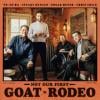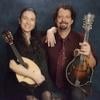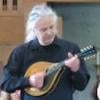
As I’ve written before, we are in a golden age of mandolin playing. Perhaps the artist most responsible for the current renaissance is David Grisman. For nearly 60 years now, the mandolinist has been pushing the boundaries of what the instrument can do and he’s done so across a range of genres including folk, old-time music, bluegrass, newgrass, Hot-Club-style swing, jazz, Latin-American tunes, rock ’n’ roll, and classical music.
Along the way, Grisman melded all of these styles and influences into an identifiable idiom of new acoustic music often referred to “Dawg Music,” a moniker based on the mandolinist’s nickname. His sound is almost instantly recognizable, characterized by crisp, precise attacks, warm tone, smooth vibrato, and indomitable drive. The New York Times once described him this way: “Plinking away at nearly the speed of sound, David Grisman is the Paganini of the mandolin.”
I first encountered Grisman’s music entirely by accident in 1968, when I picked up an album by Earth Opera, a psychedelic folk-rock ensemble touted as part of the emerging “Bosstown sound.” Grisman played mandolin and mandocello in the band, instruments that seemed wildly improbable and exotic in the context of a rock group, and Peter Rowan provided the ethereal vocals. Two years later, his jaunty mandolin leapt out of the speakers on a couple tracks on the Grateful Dead’s American Beauty record and I recognized a sound I liked.
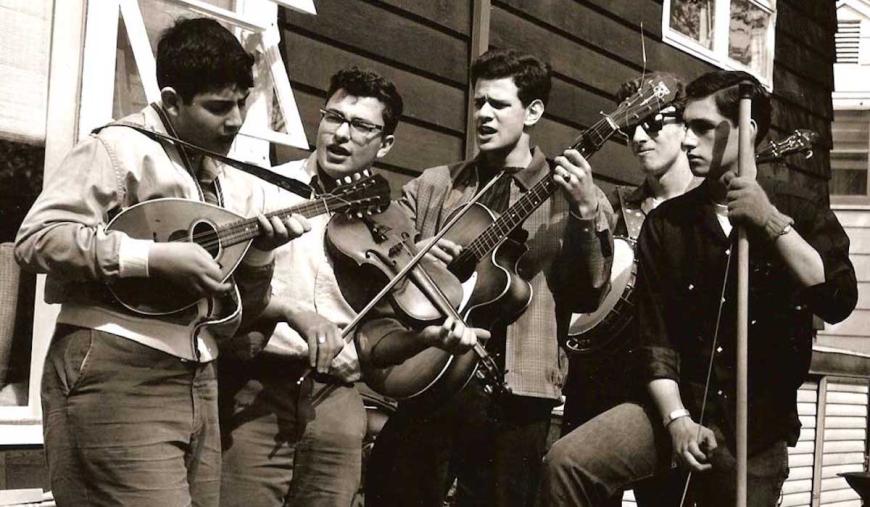
Within a year or two, I was listening to bluegrass and more roots-oriented music, and suddenly I was hearing Grisman’s mandolin everywhere — with Red Allen & the Kentuckians, on a Don Stover album, and as a featured guest on a lot of great new records. Not long after that, Grisman started releasing albums of his own and I was hooked. He became my favorite mandolinist.
It’s been hard to keep up with his output over the years. Even a brief perusal of Grisman’s discography proves a daunting task. His output as band leader and featured performer comprises over 50 recordings, with a kaleidoscopic cadre of collaborators, some in his own ensembles and some in a constant stream of duets with artists ranging from folksingers and fiddlers to swing guitarists, jazz pianists, and more.
In addition to his own projects, his roster of guest appearances with other artists runs to well over 200 entries. Even those who haven’t followed his career are likely to have heard Grisman’s playing somewhere. In addition to guest turns on recordings by the likes of Maria Muldaur, Dolly Parton, James Taylor, Bonnie Raitt, Linda Ronstadt, the aforementioned Grateful Dead, and a long list of others, his “Dawggy Mountain Breakdown” was the theme for Tom and Ray Magliozzi’s wildly popular Car Talk radio program on NPR. He’s written the music for several feature films including Capone and King of the Gypsies, and he and Stephane Grappelli appeared in the guise of a “Gypsy” band in the latter.
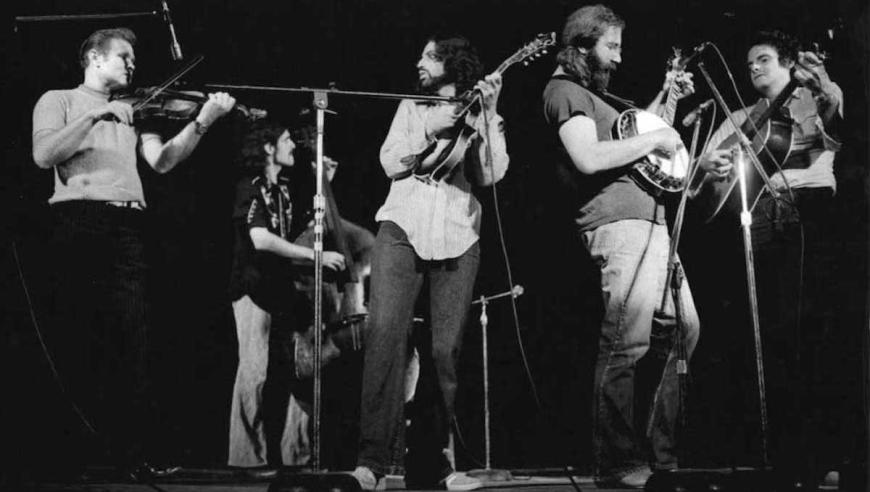
In order to gain more control over his recording career, he founded Acoustic Disc, his own record label, which in addition to supporting his own projects, has supported many outstanding and historically significant artists such as the brilliant Brazillian choro mandolinist Jacob “do Bandolim” Bittencourt, the Russian virtuoso Dave Apollon, the San Francisco mandolinist and prolific composer Rudy Cippola, and many more.
Here then, in roughly chronological order, is a sampler of Grisman’s work. I’ve shoehorned in some related recordings here and there, but bear in mind that for every disc listed below, and four or five are waiting for you to discover.
Early Dawg (1980 – Sugar Hill)
This collection of early Grisman recordings was released in 1980, but the previously unreleased, mostly live performances date from 1966, with one track from 1973. Straight-ahead bluegrass featuring Del McCoury on guitar and vocals, Jerry McCoury on bass, Bill Keith on banjo, and others, with Grisman’s instrumental prowess on display from the opening “Fanny Hill” through the blistering closing duet with mandolinist Frank Wakefield.
Old & In the Way (1975)
For years decades this record was the world’s best-selling bluegrass recording, due in no small part to the presence of Grateful Dead guitarist Jerry Garcia as the group’s banjo player. The group also featured fiddle virtuoso Vassar Clements, Peter Rowan on guitar and vocals, and bassist John Kahn. Recorded Oct. 8, 1973, at the Boarding House in San Francisco by the renowned sound engineer and LSD chemist Owsley Stanley, the disc captured one of the very few performances by the short-lived group. Balancing bluegrass standards such as the Stanley Brothers’ “Pig in a Pen” with new songs from Rowan, Grisman, and even the Rolling Stones, the band hit gold with their loose blend of bluegrass instrumentation with a looser, open-ended improvisational approach. At the time there were numerous progressive “newgrass” bands pushing the envelope in terms of harmonic and rhythmic ideas, song structure, and arrangements, and this album became the template for subsequent “jamgrass” bands. Grisman’s Acoustic Disc label has released additional recordings of the band.
The David Grisman Rounder Record (1976 – Rounder)
Grisman assembled an all-star band of bluegrass greats to play on this first release under his own name. The group included fiddlers Vassar Clements and Ricky Skaggs, guitarist Tony Rice, banjo players Tony Trishka and Bill Keith, Dobro player Jerry Douglas, and bassist Todd Philips. Although there are hints of the direction he was about to take with later projects, the record hewed close to the bluegrass tradition, from the welcoming old-time-radio “Hello” through a program of mostly up-tempo bluegrass standards from Bill Monroe and Flatt and Scruggs to a somber gospel number, mixed with rollicking hoedowns and a few Grisman originals. Great playing and singing throughout.
The David Grisman Quintet (1977 – Kaleidoscope)
An Irish musician friend told me that when he heard this record, “it blew the head right off me.” Me, too. The stylistic elements that had been coalescing in earlier projects all came into tight focus on this release. Grisman assembled a crackerjack band here, with Tony Rice on guitar, Darol Anger on fiddle, Todd Phillips on mandolin, and Bill Amatneek on bass, and he switched up the traditional bluegrass-band format by adding a second mandolin instead of the usual banjo. Twin fiddles were common in bluegrass settings, but the twin mandolin idea was something new, and it placed the focus squarely on the eight-string. Grisman’s tunes on earlier recordings tended to follow the conventional 32-bar format of old-time fiddle tunes, but the pieces on Quintet were more fully realized compositions, with elaborate arrangements that owed as much or more to classical music and jazz as they did to string-band repertory. Still my favorite of any Grisman recording. Fans of this album will also enjoy Hot Dawg, released the following year.
Quintet ’80 (1980 – Warner Bros.)
There was a change in personnel for this disc, with Mike Marshall on mandolin, guitar, and fiddle, Mark O’Connor on guitar, bassist Rob Wasserman, and guest cellist Joan Jeanrenaud joining Grisman and Anger for a set of originals more-or-less in the same vein as the previous couple of Quintet records. No new ground broken here, but the change in players yielded a different feel to the solos, and I particularly like Grisman’s minimalist take on John Coltrane’s ballad “Naima.”
Stephane Grappelli/David Grisman Live (1981 – Warner Bros.)
The same lineup as on Quintet ’80 became the backup band for Hot Club violinist Stephane Grappelli’s 1979 tour. Given the influence Django Reinhardt and Stephane Grappelli had on Grisman and his cohorts, this was a logical step. I was lucky enough to see one of those shows, and it brilliantly showcased the strengths of every musician in the group, and Grappelli seemed to be having the time of his life. The material is heavy on swing standards that lend themselves to many choruses of improvised soloing.
A few years later Grisman and a different combo played much the same role in support of Danish jazz violinist Svend Asmussen, again mostly playing swing standards and a few originals. The resulting Svingin’ With Svend (1987 – Zebra) includes both live and studio cuts. Hard copies are scarce as hen’s teeth, but it’s a terrific intro to one of Scandinavia’s greatest jazz players.
Home Is Where the Heart Is (1988 – Rounder)
Grisman returned to his bluegrass roots (and to Rounder Records) for this 24-track bonanza of bluegrass favorites performed by a who’s who of the genre — 22 first-call musicians in all. Even die-hard traditionalists who give short shrift to the whole “Dawg music” scene are quick to acknowledge Grisman’s chops, and the recording is a virtual tutorial in how to play bluegrass mandolin with style. Again, hard copies are a bit scarce, but the tracks are available for download.
Tone Poems (1994 – Acoustic Disc)
Guitarist Tony Rice teamed up with Grisman once again for Tone Poems: The Sounds of the Great Vintage Guitars and Mandolins, an album of duets played on vintage instruments. Both Grisman and Rice were strongly associated with specific instruments: Tony Rice with a 1935 Martin D-28 guitar that had previously belonged to legendary guitarist Clarence White, and Grisman a 1922 Gibson “Lloyd Loar” F-5 model dubbed “Crusher” for its incredible tone, volume, and projection. On this duet project, though, the pair opt for a different combination of vintage guitar and mandolin for each of the 15 tracks, with the intent of shining light on the tonal qualities of the instruments themselves. Released with a lavish, full-color booklet, the release is a “mini-reference work on some of the finest hand-crafted acoustic instruments ever built.” Grisman later released similar duets with guitarists Martin Taylor, Mike Auldridge, and Bob Brozman on Tone Poems II and III.
Dawganova (1995 – Acoustic Disc)
The Dawg heads south of the border on this excursion with yet another iteration of the DGQ, this time with Argentine guitar virtuoso Enrique Coria, flutist Matt Eakle, bassist Jim Kerwin, and percussionist and fiddler Joe Craven. Grisman originals go cheek-to-cheek with Latin standards such as “El Cumbanchero” and “Tico Tico.” The nylon-strung guitar, flute, and percussion take the combo pretty far from Grisman’s bluegrass roots into choro territory, but the energy and virtuoso attack are all there.
Shady Grove (1996 – Acoustic Disc)
Jerry Garcia and Grisman teamed up to play and record as a duet several times in the early ’90s, with Garcia playing mostly acoustic guitar rather than banjo, but they mixed it up. Jerry Garcia/David Grisman (1991) straddled the fence between Dawg music and more traditional material, Not for Kids Only (1993) was a playful romp through old chestnuts and familiar children’s tunes from the folk world. Released after Garcia’s death in 1995, So What (1998) explored their common interest in jazz, and completists will also want to check out The Pizza Tapes (2000), home recordings made with guitarist Tony Rice in the mix, and Been All Around This World (2004). My favorite of their collaborations is Shady Grove, a relaxed collection of traditional songs and ballads. Garcia’s singing is world-weary yet apt for this folksy collection, and it’s nice to hear Grisman match his laid-back approach. Multi-instrumentalist Joe Craven, bassist Jim Kerwin, a few other guests provide subtle support throughout.
Doc & Dawg (1997 – Acoustic Disc)
Guitar legend Arthel “Doc” Watson influenced generations of bluegrass and folk musicians; he and Grisman first played together in the ’60s. This collection of 14 tracks is gleaned from Watson’s numerous visits to Grisman’s home studio over the years and it’s a delight to hear the two of them breathe new life into this collection of primarily traditional and bluegrass material. My favorite track is “Watson Blues” by the father of bluegrass, Bill Monroe, who also played and recorded with Watson.
Grateful Dawg (2002 – Sony)
Gillian Grisman directed this award-winning documentary of the long music friendship between Jerry Garcia and David Grisman — “beards of a feather” — and captures the two doing what they did best: making music. The candid film incorporates rare concert footage, never-before-released recordings and exclusive home video of private jam sessions. Available for streaming on Amazon Prime.
Pickin’ (2017 – Acoustic Disc)
Grisman has played with many of the greatest acoustic guitarists of the past 50 years. Australian fingerstyle guitarist Tommy Emmanuel can go toe-to-toe with any of them. Plenty of hot picking here, but some lovely waltzes as well.
The Dawg Trio (2019 – Acoustic Disc)
On his latest disc, Grisman is joined by his son Samson Grisman on bass and multi-instrumentalist/singer/songwriter Danny Barnes for a set of nine new Dawg compositions and three new Barnes songs. Recorded “live” in the studio, the record features a relaxed, lean approach that covers all the bases with panache.



